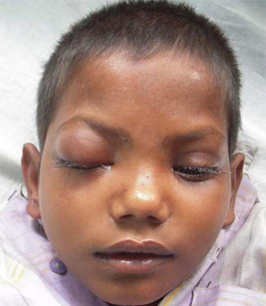Summary
Definition
History and exam
Key diagnostic factors
- rapid onset of signs and symptoms (acute septic cavernous sinus thrombosis)
- headache
- fever
- periorbital edema
- chemosis and proptosis
- lateral gaze palsy
- ophthalmoplegia
- profound sepsis (acute septic cavernous sinus thrombosis [CST])
Other diagnostic factors
- ptosis and mydriasis
- papilledema and/or retinal-vein dilatation
- decreased corneal reflex
- hypo- or hyperesthesia in the distribution of the ophthalmic and maxillary nerves
- mental state changes (e.g., confusion, drowsiness, coma)
- clinically detectable primary infection site
- meningismus (nuchal rigidity, photophobia, and headache)
- positive Kernig or Brudzinski signs
- seizures
- loss of visual acuity
Risk factors
- recent history of acute sinusitis
- history of facial infections
- history of periorbital infection
- history of otitis media, mastoiditis, or petrositis
- history of dental or oral infection
- history of sepsis
- immunosuppression
- genetic prothrombotic condition
- acquired and other prothrombotic states
- history of head and neck trauma
- use of oral contraceptives
- pregnant or postpartum
- history of malignancy
- history of recent head or neck surgery
- vascular abnormalities
- ulcerative colitis
- volume depletion
- heroin overdose
Diagnostic tests
1st tests to order
- CBC
- contrast-enhanced high-resolution CT of head
- contrast-enhanced MRI of head
- blood culture
- microscopy and culture of suppurative fluid or tissue from primary infective source
- antiphospholid and anticardiolipin antibodies
- protein S and protein C
- antithrombin III
- factor V Leiden
- hemoglobin electrophoresis
- D-dimer level
Tests to consider
- lumbar puncture with cerebrospinal fluid analysis
Treatment algorithm
suspected cavernous sinus thrombosis (CST)
confirmed septic cavernous sinus thrombosis (CST): without hemorrhagic complications
confirmed septic cavernous sinus thrombosis (CST): with hemorrhagic complications
confirmed aseptic cavernous sinus thrombosis (CST): without hemorrhagic complications
confirmed aseptic cavernous sinus thrombosis (CST): with hemorrhagic complications
Contributors
Authors
Jayant Pinto, MD
Associate Professor of Surgery
Section of Otolaryngology-Head and Neck Surgery
University of Chicago
IL
გაფრთხილება:
JMP has received funds from Regeneron, Sanofi, and Optinose for speaker's bureau and advisory boards. He served as a site investigator for Regeneron, Sanofi, and Upstream Bio.
Mohamad R. Chaaban, MD, MSCR, MBA
Associate Professor
Cleveland Clinic
Lerner College of Medicine at Case Western Reserve University
Cleveland
OH
გაფრთხილება:
MRC has no competing interests.
რეცენზენტები
David Rowed, MD
Division of Neurosurgery
University of Toronto
Toronto
Ontario
Canada
გაფრთხილება:
DR declares that he has no competing interests.
Louis R. Caplan, MD
Lecturer in Neurology
Hospital Chief
Cerebrovascular/Stroke Division
Beth Israel Deaconess Medical Center
Division of Cerebrovascular/Stroke
Boston
MA
გაფრთხილება:
LRC declares that he has no competing interests.
Sorabh Khandelwal, MD
Clinical Associate Professor of Emergency Medicine
Ohio State University
Columbus
OH
გაფრთხილება:
SK declares that he has no competing interests.
რეცენზენტების განცხადებები
BMJ Best Practice-ის თემების განახლება სხვადასხვა პერიოდულობით ხდება მტკიცებულებებისა და რეკომენდაციების განვითარების შესაბამისად. ქვემოთ ჩამოთვლილმა რეცენზენტებმა თემის არსებობის მანძილზე კონტენტს ერთხელ მაინც გადახედეს.
გაფრთხილება
რეცენზენტების აფილიაციები და გაფრთხილებები მოცემულია გადახედვის მომენტისთვის.
წყაროები
ძირითადი სტატიები
Ebright JR, Pace MT, Niazi AF. Septic thrombosis of the cavernous sinuses. Arch Intern Med. 2001 Dec 10-24;161(22):2671-6.სრული ტექსტი აბსტრაქტი
Caranfa JT, Yoon MK. Septic cavernous sinus thrombosis: a review. Surv Ophthalmol. 2021 Nov-Dec;66(6):1021-30. აბსტრაქტი
Bhatia K, Jones NS. Septic cavernous sinus thrombosis secondary to sinusitis: are anticoagulants indicated? A review of the literature. J Laryngol Otol. 2002 Sep;116(9):667-76. აბსტრაქტი
American College of Radiology. ACR appropriateness criteria: headache. 2022 [internet publication].სრული ტექსტი
American College of Radiology. ACR appropriateness criteria: orbits, vision, and visual loss. 2017 [internet publication].სრული ტექსტი
გამოყენებული სტატიები
ამ თემაში მოხსენიებული წყაროების სრული სია ხელმისაწვდომია მომხმარებლებისთვის, რომლებსაც აქვთ წვდომა BMJ Best Practice-ის ყველა ნაწილზე.

დიფერენციული დიაგნოზები
- Periorbital or orbital cellulitis
- Superior orbital fissure syndrome
- Orbital apex syndrome
მეტი დიფერენციული დიაგნოზებიგაიდლაინები
- ACR appropriateness criteria: cerebrovascular diseases-stroke and stroke-related conditions
- ACR appropriateness criteria: headache
მეტი გაიდლაინებიპაციენტის ბროშურები
Meningitis and septicemia
Preventing another stroke
მეტი პაციენტის ბროშურებიშედით სისტემაში ან გამოიწერეთ BMJ Best Practice
ამ მასალის გამოყენება ექვემდებარება ჩვენს განცხადებას